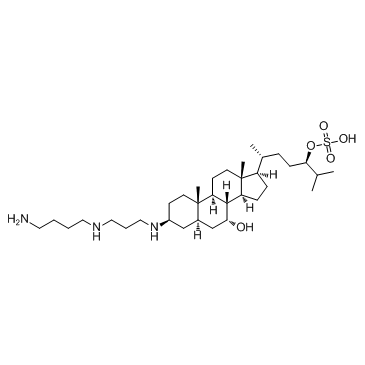Squalamine
Modify Date: 2025-08-23 09:55:21

Squalamine structure
|
Common Name | Squalamine | ||
|---|---|---|---|---|
| CAS Number | 148717-90-2 | Molecular Weight | 627.96200 | |
| Density | 1.13g/cm3 | Boiling Point | N/A | |
| Molecular Formula | C34H65N3O5S | Melting Point | N/A | |
| MSDS | N/A | Flash Point | N/A | |
Use of SqualamineSqualamine(MSI-1256) is an aminosterol compound with potent broad spectrum antiviral activity.IC50 value: Target: in vitro: squalamine can strongly displace membrane-bound cationic proteins such as Rac1, a ρ-GTPase recruited to the inner leaflet of the eukaryotic cytoplasmic membrane for the actin remodeling necessary for endocytosis. At concentrations between 20 and 60 μg/mL, squalamine has been shown to inhibit a broad array of growth factor-induced, actin-dependent responses in endothelial cells, including cell migration, cell division, and vascular tube formation in a 3D matrix [1]. Squalamine effectively inhibited HBV replication in human primary hepatocytes when added either during the initial exposure of virus to the cells or at 24 h after infection. A similar study was performed to evaluate the effect of squalamine on the replication of HDV. Squalamine was introduced at 20 μg/mL during HDV exposure, and the effects were measured at day 7 when total RNA was extracted and assayed for HDV RNA sequences [1]. in vivo: one time daily treatment with squalamine (15 or 30 mg/kg per d s.c.) was started beginning on day 1 or 2 after viral administration and continuing until day 8 or 9, respectively. Survival was monitored, and animals that remained alive by day 21 were considered cured [1]. |
| Name | squalamine |
|---|
| Description | Squalamine(MSI-1256) is an aminosterol compound with potent broad spectrum antiviral activity.IC50 value: Target: in vitro: squalamine can strongly displace membrane-bound cationic proteins such as Rac1, a ρ-GTPase recruited to the inner leaflet of the eukaryotic cytoplasmic membrane for the actin remodeling necessary for endocytosis. At concentrations between 20 and 60 μg/mL, squalamine has been shown to inhibit a broad array of growth factor-induced, actin-dependent responses in endothelial cells, including cell migration, cell division, and vascular tube formation in a 3D matrix [1]. Squalamine effectively inhibited HBV replication in human primary hepatocytes when added either during the initial exposure of virus to the cells or at 24 h after infection. A similar study was performed to evaluate the effect of squalamine on the replication of HDV. Squalamine was introduced at 20 μg/mL during HDV exposure, and the effects were measured at day 7 when total RNA was extracted and assayed for HDV RNA sequences [1]. in vivo: one time daily treatment with squalamine (15 or 30 mg/kg per d s.c.) was started beginning on day 1 or 2 after viral administration and continuing until day 8 or 9, respectively. Survival was monitored, and animals that remained alive by day 21 were considered cured [1]. |
|---|---|
| Related Catalog | |
| References |
| Density | 1.13g/cm3 |
|---|---|
| Molecular Formula | C34H65N3O5S |
| Molecular Weight | 627.96200 |
| Exact Mass | 627.46400 |
| PSA | 142.29000 |
| LogP | 8.11610 |
| Index of Refraction | 1.548 |
| Storage condition | -20°C |